In this Article...
One common question that I get is how to access AutoCAD command quickly.
AutoCAD is a 30 years old software. People already use it before it runs on Windows. It was designed to run on different operating system and different standard interface until today. That’s why there are many methods to access AutoCAD commands. One method may be faster in general, but other method can be faster when doing other tasks.
For example command line is faster for most AutoCAD users for activating line command. But Function keys are faster to toggle Ortho mode. It would be better for you to know other methods, so you can decide which one works best for you.
So let’s try to explore all methods that you can use to use AutoCAD commands and see how you can use them effectively.
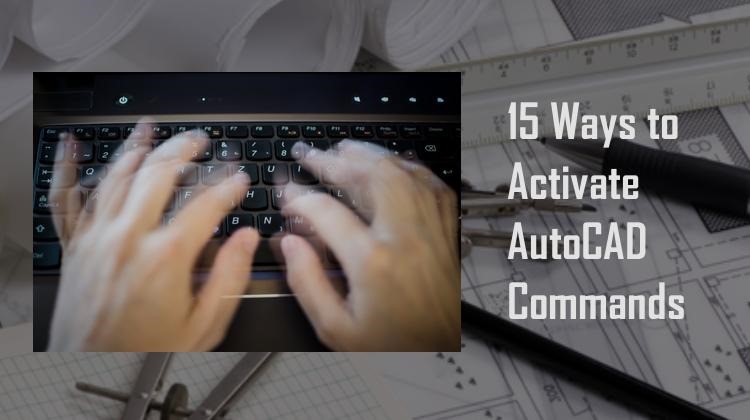
1. From AutoCAD Ribbon
Ribbon was introduced in AutoCAD 2009. If you learn AutoCAD after this version, you probably use this as primary method. I found that many occasional users also like ribbon. I’m not suggesting it’s the best method, but I do like it than toolbar.

Many AutoCAD veterans don’t like ribbon, because it’s a big change from toolbar to ribbon. It feels slow (personally I feel it becomes better in later version) and take too much screen real estate.
Ribbon doesn’t bother me too much, in prior to 2009 I don’t use toolbar that much anyway.
This is the most apparent way to activate a command in latest version. Even if you’ve never seen AutoCAD in your entire life, you know you can activate a command from here.
2. From Quick Access Toolbar
Quick Access Toolbar (QAT) comes with ribbon interface. It contains most frequently used AutoCAD tools.

If there are AutoCAD commands that you use often, you can place them here. Simply right click a command, then choose Add to Quick Access Toolbar in context menu.
3. Toolbar
Toolbar is a method to activate a command with graphical user interface, before we have ribbon. Each toolbar has several similar tools. You need to remember the icon because there is no label next to the icon. Yes, there’s tool tip to help you identify a tool. But it’s still not easy to find a tool if you use AutoCAD occasionally.
The benefit of using toolbar is it takes less space than Ribbon.

Since AutoCAD 2015, you need to create your own Classic Workspace if you want to use toolbar. You can read how to show AutoCAD toolbar here. And if you are familiar with CUI, you can show toolbar using CUI like shown here.
4. AutoCAD Menu
Like toolbar, AutoCAD menu is not shown by default. It’s available in Classic Workspace, but you can still use it.

What I like about menu is, I can always find the command I want there. If I can’t find it on ribbon or toolbar, I can find it on menu. It’s more detailed and straightforward for me.
If you want to use AutoCAD menu, change the MENUBAR system variable to 1. Change it again to 0 if you want to hide it.
5. Command Line
Veteran AutoCAD users love command line. When I teach other software to them, they always ask if the software had similar feature. Not many software use it. So command line makes AutoCAD quite unique.
Instead of using mouse and clicking the icons, you can type the commands here.
![]()
Command line has become more advanced, even new users can use it easily. It has AutoCorrect, AutoComplete and Synonym Suggestions that help you if you don’t know the command.
You don’t have to remember the exact command, you can type it in command line and AutoCAD will suggest it for you. Then you can choose it from the list.
6. Context Menu
Context menu is a standard Windows interface. We have it in every software.
If you select an object and click the right mouse button, you will see menu related to the object. What you can do to that particular object.
For example if you select a polyline, you will see Edit Polyline in the list.
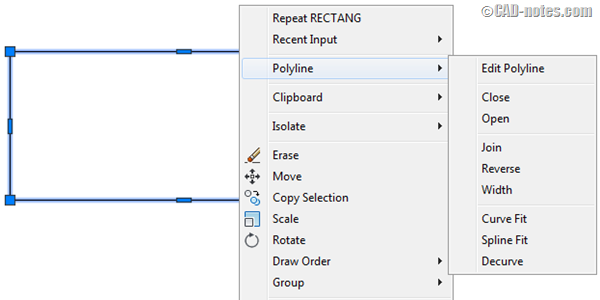
7. Multifunctional Grips
If you select an AutoCAD object, you can see it has several grips. You can access several modify tools by hovering the mouse pointer above the grip.
Similar to contextual menu, the tools are related to the object you selected.
In this example below, you can see multifunctional grips menu for dimension.
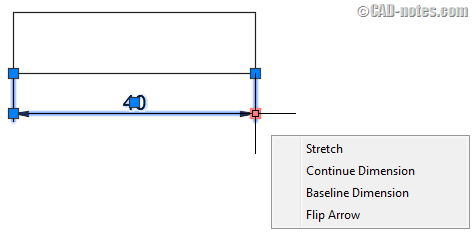
8. Tool Palette
If you need to create object with specific properties, tool Palette is a great way to activate command. It’s not limited to inserting a block, you can use it for many AutoCAD drawing tools.
For example if you need to draw line on layer “centerline”, you can choose it from tool palette. Your line will be created on centerline layer, regardless what layer is current.
Tool palette is very easy to customize. You just need to drag and drop objects to the palette.
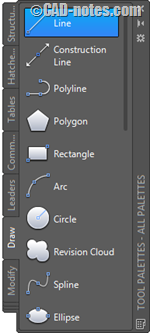
9. Other places
There are other locations where you can activate AutoCAD commands. But in these locations, the commands you can access are limited.
Application Menu
![]()
Application menu is the big A symbol. Most commands here are related to file. Like save, open, print and recover.
View Cube and Navigation Bar
View Cube and Navigation bar are on the right side of your drawing area. You can access navigation command here, like zoom and pan.
In-canvas Viewport control
![]()
You can use In-canvas viewport control to quickly access Model Viewport, Views and View Styles.
Status Bar
At the right bottom of status bar, you can see many buttons there. They are settings toggles. You can turn on/off some settings quickly here. Like OSNAP and ORTHOMODE.
Activating AutoCAD commands with Shortcuts
Now let’s see the fun part. Because AutoCAD has so many options to activate commands, there are many shortcuts that you can use. You can access a command quicker than moving your mouse and click the icon.
10. Ribbon Shortcuts
Yes, ribbon has shortcuts too. Press ALT key once, you will see letters above the tabs. Press H for home then you will see letters on each tool.

If you use ribbon, this is a nice way to activate a command quickly. Or move to other tab without moving your mouse pointer.
*This shortcut doesn’t work if you show menu bar (MENUBAR=1).
11. Command Alias
When using command line, you can use the command alias for faster access. For example L is alias for LINE. X is alias for EXPLODE.
You can easily modify the command alias to match your preference.
For example I prefer to change CO to CC for COPY command. The reason is I can type C twice faster and less mistakes than pressing C then O.
If you have Express Tools installed, you can Command Aliases tool (ALIASEDIT) to modify command aliases easily.
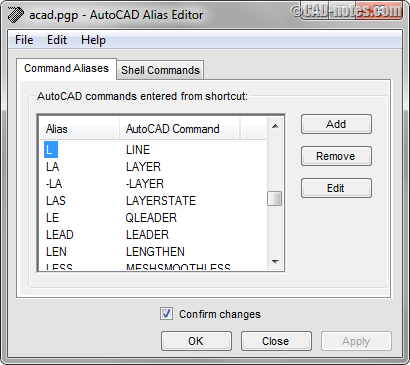
12. Function Keys
Function keys are the key between F1 to F12. Image below shows what does each function key do.

Image source: http://www.autodesk.com/store/autocad/autocad-shortcuts#one-key
13. Windows Shortcut Keys
AutoCAD has been a Windows software for a long time. So most Windows shortcuts work in AutoCAD. You can press CTRL + C to copy to clipboard. CTRL + P for print. CTRL + A for select all. If you often use them in other software, don’t worry. You can also use them in AutoCAD.
There’s also Mac version, but I don’t use Mac so I don’t know if there are shortcuts like in Windows. If you use AutoCAD for Mac, I appreciate if you share it in comment section here.
14. AutoCAD Specific Shortcut Keys
Besides the Windows shortcut keys, AutoCAD has specific shortcut keys. These shortcut keys only work in AutoCAD.
CTRL + SHIFT + I toggles Infer Constraint. CTRL + 0 will activate clean screen. CTRL + 1 will open properties palette. There are many shortcut keys that you can use, and you can make your own keys.
You can see the shortcut keys list in CUI or you can download shortcut keys list in this document.
15. Temporary Override Keys
You can use Temporary Override keys to override settings when you work. For example if you want to snap to center, you can hold SHIFT + C.
You can see the temporary override keys list in CUI or you can download shortcut keys list in this document.
What is your favorite way to activate AutoCAD command?
There are so many ways to activate commands. I listed 15 here, but you may can help me to add more!
I excluded old functions like screen menus, because it is obsolete and I think no one use it anymore.
What do you think? Which one do you use and help you work faster? I don’t believe that you only use one method.
Share with us in this comment area, maybe we can learn from you too!




My cad program sometimes randomly changes settings so clicking the toolbar buttons doesn’t work, and the program only accepts key-in commands. I used to remember the key-in command to change this setting back, but I don’t remember it anymore. A google search has been fruitless. Thanks!
FILEDIA
Finally remembered it! Isn’t it so annoying how this setting randomly switches. It’s been happening for years!
Hi Keiv,
Yes, FILEDIA is quite annoying :)
You can monitor System Variable changes by using System Variable Monitor. It gives you warnings when a variable is changed. This feature is available since AutoCAD 2016.
Very nice compilation of ways to use the tools and commands of Autocad, Thank you so much for sharing this list.
Have you seen the latest logo of Arcadis? Seem a little similarity between fonts and colors of your logo. Just wondering only.
I have been using AutoCAD since R9 and prior to that I used Medusa (Prime Computer – Late 1980’s).
Back then we had digitizer menus and multi button pucks to pick commands off of a menu on the digitizer. This was in addition to screen menus and pull downs (I think the old screen menus are still available in AutoCAD but I don’t know if many people use them).
I customized our menus where I work many years ago to work on the old digitizer menus. Then when toolbars came along, I created toolbars for all of the work we do (Isometrics, P&ID’s, Electrical One Lines, etc). I also revised a lot of LISP routines to use dialog boxes when we were given the ability to create our own.
I do like the Ribbon Bars in the way they change automatically based on the command you are using – hatch, Mtext, etc. Finding things on the Ribbon took me a little to get used to, but like anything else, it is customizable.
But the thing I use more than anything else is Command Aliases, I have one hand on the keyboard and one on the trackball.
Very interesting Don.
I started using AutoCAD when it’s already use toolbars. From your experience, is toolbar better than old GUI?
Yes, screen menus are still available, but you need to redefine it first if you want to use it.
Well Edwin, the draw back to the old digitizer tablets is it required you to take your eyes off the screen and look down at the tablet to find the command. You were limited in size to how many commands you could have on the tablet menu. You were allowed to have “overlays” where you could change portions of the tablet menu. So if you did electrical drawings, you could set the upper portion of the tablet menu with electrical symbols and routines. Then if you switched to mechanical drawings, you could change that portion of the tablet menu with mechanical symbols and routines.
Customizing menus was a lot more tedious than it is now. It was all typed in, then you had to compile it and load it. Now the CUI menu allows you to change it on the fly. I have to admit, it took me awhile to like the CUI menus but they are much easier to customize now.
But with toolbars, it is easier to create toolbars to fit your needs and you can easily turn them on and off depending on the type of drawing you are working on.
thanks for your. permetion
AutoCAD is not the only command line software out there. Besides the clones you mentioned there is also Rhinoceros or Rhino for short. It is very similar to AutoCAD in its user interface.
Thank you for the correction Mark!
I know about Rhino but I’ve never used it. I already updated the article.
I think the most useful feature about the different methods of inputting an AutoCAD command is that you can customize any particular feature. You mention the tool pallet where you can switch to a different layer and then execute the command and draw on that layer. You can modify all input methods to do the same thing. You can switch layers to draw specific items on, without having to change layers from a layer pull-down list.. For example, you have 3 layers, one for lines, one for rectangles and one for circles. You modify the line command input to change the current layer to the line layer. You then do the same for the circle and rectangle command changing the layer to “circle” and “rectangle”. This saves you changing layers. It also ensures that the three items will be drawn on the correct layer. Now, because nothing ever stays the same, when you need yellow and green circles, you only have to copy the “circle” command and change the layer to the “green circle layer”, and “yellow circle layer”. The biggest use of time with AutoCAD is changing layers. The more layers you have, the more flexible your drawing becomes and with menu setting of layers, the more productive you become.
Yes, we can customize anything in AutoCAD. Tool Palettes is great for people who don’t know or don’t want to learn about programming or macro.
I prefer to use LISP for changing layers or create object on specific layer. For example CLWALL will change current layer to WALL. Or DRwALL to change layer to WALL and activate line tool.
The default position of the Quick Access Toolbar is above the Ribbon, where it has to compete with the file name and everything else at the top of the screen. By right-clicking on the arrow at the far right of the QAT, you can select “Show QAT below the Ribbon”. This allows much more space for your most frequently used tools.
Thank you for sharing the tip Eric! Yes, QAT is better below the ribbon for me too!